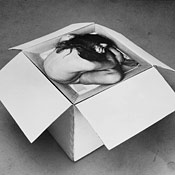Home > Arts & Events > Art >
- PROFILE
- READER REVIEWS
Wack! Art and the Feminist Revolution
|
|
Price
$5 suggested donation, $2 students and seniors, free with MoMA admission
Reservations
No Recommendation
Nearby Subway Stops
G at 21st St.; E, M at Court Sq.-23rd St.; 7, G at Court Sq.
Schedule
There are no more dates for this event.
Profile
Much of the art in “WACK! Art and the Feminist Revolution” is fully experimental, made by the seat of its jeans and pleats of its skirts. In fact, the best way to look at the show is as a walk-in catalogue, a consciousness- raising session, and a class reunion. It’s devoted to the artistic soldiers of the women’s movement from 1965 to 1980, and it’s all here, the good and the bad: cringe-inducing off-the-wall goddess worship, icky dirty-hippie art, lighter-than-air pattern-and-decoration painting, porn as art, breast-beating, bra-burning, the joys and sorrows of second-wave sex, man-hating, woman-loving, bushy hair, aviator glasses, and the revolutionary power of women’s laughter and anger. Nearly every trope in favor today—from photography-based painting to performance, appropriation, scatter art, process art, endurance art, “Relational Aesthetics,” and institutional critique—was either invented or extended back then. This P.S. 1 show is loaded with DIY ingenuity, passion, and literal blood and guts.
There’s so much to be knocked out by: Joan Semmel’s photorealistic paintings of herself having sex seen from her point of view, Shigeko Kubota painting with a brush stuck to her crotch, Cosey Fanni Tutti posing in porn magazines, Eleanor Antin documenting herself on a diet, and Carolee Schneemann pulling a scroll from her vagina and reading it. It’s a rush of old memories and the lust for life.
Let one example suffice for all. Compare Tee Corinne’s explicit little pencil drawing of female genitalia, from her Cunt Coloring Book, to the most famous rendition of the subject in all of art, Courbet’s Origin of the World, which is on view right now at the Met. Courbet’s magnificent eye-peeling, psyche-challenging spread-eagle essentially depicts the dark mystery of female sexuality, the vagina as void. Everything in the painting simultaneously hits you in the face and pulls you into the shadowy cleft. Corinne’s drawing is nowhere near as powerful, but it is far more anatomically detailed and infused with feeling. Instead of obdurateness she gives us labial interface, clitoral hood, flesh, texture, wrinkles, different thicknesses of skin, and so on. Courbet’s painting is one vagina as all vaginas, a source-of-the-Nile Ur-vagina. Corinne’s is about specificity, sensation, vulnerability, and voluptuousness. If Courbet’s work is woman as Venus flytrap, Corinne’s is more like woman as Delta of Venus. Most interesting, however, she also subtly transfers the idea of male sexual power through phallic visibility to the female sex organ.
Expertly organized by the Museum of Modern Art’s chief drawings curator, Connie Butler, “WACK!” is also an occasion to ask yet again about female representation in the art world, an issue that I’ve discussed here before. In 1972 it was hard for women to get their work into galleries and museums. Yet it was impossible to be in the art world then and not be totally aware of the form-changing dynamism of women’s art. Today, museums love the art of the period. They do massive survey exhibitions of Smithson and Serra. Where are the surveys of Lynda Benglis, Dorothea Rockburne, Adrian Piper, and Sturtevant? By my count, totaling up the shows and projects at the Guggenheim since 2000, only 24 percent are by women. MoMA and the Whitney are a few percent better. The gallery scene is even worse: One Saturday three weeks ago, I checked out every show in every ground-floor gallery in Chelsea from 18th Street to 26th Street. Of 74 solos, only 16 percent were by women. The art in “WACK!” may have changed the way art looks—but it didn’t quite change the way it works.

